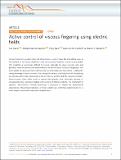| dc.contributor.author | Gao, Tao | |
| dc.contributor.author | Mirzadeh, Seyed Mohammad | |
| dc.contributor.author | Bai, Peng | |
| dc.contributor.author | Conforti, Kameron Michael | |
| dc.contributor.author | Bazant, Martin Z | |
| dc.date.accessioned | 2020-09-17T16:28:57Z | |
| dc.date.available | 2020-09-17T16:28:57Z | |
| dc.date.issued | 2019-09 | |
| dc.date.submitted | 2019-03 | |
| dc.identifier.issn | 2041-1723 | |
| dc.identifier.uri | https://hdl.handle.net/1721.1/127645 | |
| dc.description.abstract | Viscous fingering is a widely observed phenomenon, in which finger-like instabilities occur at the interface of two fluids, whenever a less viscous phase displaces a more viscous phase. This instability is notoriously difficult to control, especially for given viscosity ratio and geometry. Here we demonstrate experimentally the active control of viscous fingering of two given liquids, for given geometry and flow rate in a Hele-Shaw cell. The control is realized by taking advantage of electro-osmotic flows along the surfaces confining the fluid, via applying an external electric field. Depending on the direction of electric field, the induced secondary electro-osmotic flows either assist or oppose the hydraulic flow, effectively reducing or increasing the flow resistance, leading to the control of interface stability. The mechanism of apparent “electrokinetic thinning/thickening” is proposed to explain the experimental observations. Theoretical predictions of linear stability are confirmed experimentally for a broad range of immiscible electrolyte displacements. ©2019, The Author(s). | en_US |
| dc.language.iso | en | |
| dc.publisher | Springer Science and Business Media LLC | en_US |
| dc.relation.isversionof | https://dx.doi.org/10.1038/s41467-019-11939-7 | en_US |
| dc.rights | Creative Commons Attribution 4.0 International license | en_US |
| dc.rights.uri | https://creativecommons.org/licenses/by/4.0/ | en_US |
| dc.source | Nature | en_US |
| dc.title | Active control of viscous fingering using electric fields | en_US |
| dc.type | Article | en_US |
| dc.identifier.citation | Gao, Tao et al., "Active control of viscous fingering using electric fields." Nature Communications 10, 1 (September 2019): 4002 doi. 10.1038/s41467-019-11939-7 ©2019 Authors | en_US |
| dc.contributor.department | Massachusetts Institute of Technology. Department of Chemical Engineering | en_US |
| dc.contributor.department | Massachusetts Institute of Technology. Department of Mathematics | en_US |
| dc.relation.journal | Nature Communications | en_US |
| dc.eprint.version | Final published version | en_US |
| dc.type.uri | http://purl.org/eprint/type/JournalArticle | en_US |
| eprint.status | http://purl.org/eprint/status/PeerReviewed | en_US |
| dc.date.updated | 2019-10-22T15:44:53Z | |
| dspace.date.submission | 2019-10-22T15:44:56Z | |
| mit.journal.volume | 10 | en_US |
| mit.journal.issue | 1 | en_US |
| mit.metadata.status | Complete | |
